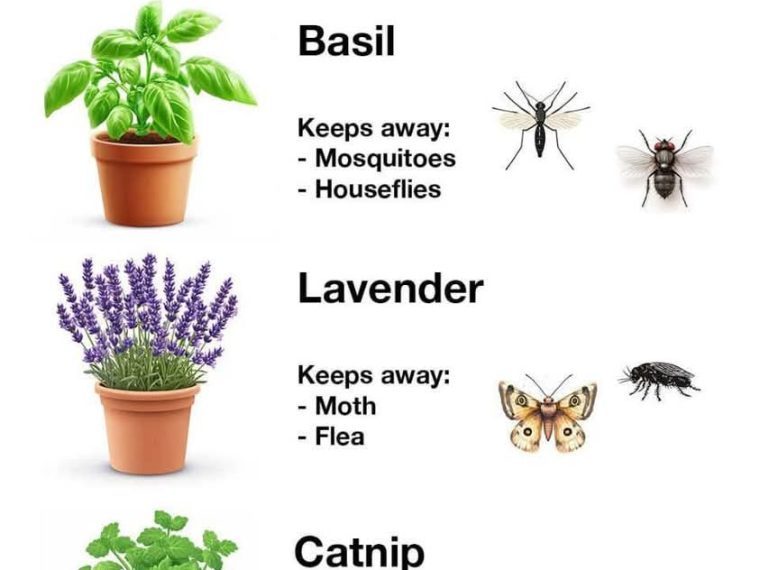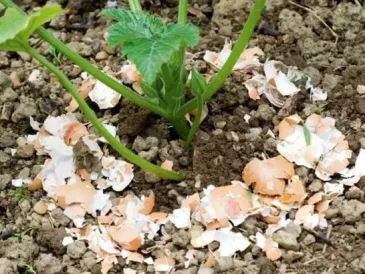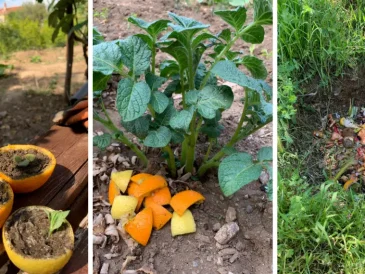Gardening can be a joyful and rewarding activity, but dealing with pests can be a real headache. From aphids to beetles, pests can wreak havoc on your plants, leaving you frustrated and desperate for solutions. While chemical pesticides are often used, they can be harmful to the environment, beneficial insects, and even humans. Thankfully, nature has provided a better way: companion planting. By choosing the right plants, you can create a natural pest-repelling garden that thrives without the need for harmful chemicals. Below, we explore 15 top plants that naturally keep pests away, ensuring a healthier, more vibrant garden.
1. Marigolds (Tagetes spp.)
Marigolds are among the most well-known pest-repelling plants, and for good reason. These vibrant flowers emit a strong scent that repels a wide variety of garden pests, including aphids, nematodes, and whiteflies. Marigolds are particularly effective at deterring mosquitoes, making them a great choice for garden beds and patios.
How It Works: The pungent smell of marigolds confuses and repels insects, making it harder for them to detect your other plants.
Best For: Companion planting with tomatoes, peppers, and other vegetables.
2. Lavender (Lavandula spp.)
Lavender is not only a fragrant herb but also a powerful pest deterrent. Its strong scent repels mosquitoes, flies, and moths, while its calming aroma is a bonus for gardeners. Lavender is often planted near outdoor seating areas to keep bugs away during summer evenings.
How It Works: The essential oils in lavender act as a natural insect repellent, masking the smells that attract pests.
Best For: Keeping mosquitoes away from patios, garden beds, and near flowering plants.
3. Basil (Ocimum basilicum)
Basil is a fantastic herb that not only adds flavor to your cooking but also helps protect your garden from pests. It repels a wide range of insects, including aphids, mosquitoes, and flies. Additionally, basil can help enhance the flavor of other plants when planted nearby.
How It Works: Basil contains essential oils, such as eugenol, that are repellent to mosquitoes and other pests.
Best For: Companion planting with tomatoes, peppers, and other garden vegetables.
4. Garlic (Allium sativum)
Garlic is an effective natural pest repellent, and its pungent aroma works wonders at keeping aphids, beetles, and mosquitoes at bay. Garlic can also be used as a natural pesticide when mixed with water and sprayed on plants.
How It Works: Garlic contains sulfur compounds that act as natural deterrents for many pests.
Best For: Keeping away aphids, beetles, and mosquitoes. Plant near roses and fruit trees for optimal results.
5. Chives (Allium schoenoprasum)
Chives are another member of the allium family, and they have a similar pest-repelling ability to garlic. Chives are particularly effective at repelling aphids, Japanese beetles, and other common garden pests. They can also enhance the flavor of nearby vegetables like tomatoes and carrots.
How It Works: Chives release a scent that confuses pests, making it harder for them to locate their target plants.
Best For: Companion planting with tomatoes, carrots, and cabbage.
6. Mint (Mentha spp.)
Mint is a fast-growing herb that can be an effective natural insect repellent. Its strong scent deters ants, mosquitoes, and flies. While mint is excellent at keeping pests away, it’s also invasive, so it’s best grown in containers or areas where it can be controlled.
How It Works: The strong menthol scent of mint repels many insects, especially mosquitoes.
Best For: Planting near seating areas, gardens, and walkways.
7. Rosemary (Rosmarinus officinalis)
Rosemary is a hardy herb that is well-known for its culinary uses, but it also serves as a potent pest repellent. Its fragrance keeps mosquitoes, flies, and even cabbage moths away, making it an excellent plant for herb gardens and vegetable patches.
How It Works: Rosemary releases oils that insects find unpleasant, helping to deter them from your garden.
Best For: Companion planting with cabbage, carrots, and beans.
8. Thyme (Thymus vulgaris)
Thyme is another herb that can be planted to repel pests. It works particularly well against aphids, cabbage worms, and whiteflies. Thyme is an easy-to-grow, low-maintenance plant that can be planted alongside your vegetables and flowers.
How It Works: Thyme’s strong aroma deters pests, while its small flowers attract pollinators to your garden.
Best For: Planting near brassicas (like cabbage and broccoli), beans, and tomatoes.
9. Nasturtiums (Tropaeolum majus)
Nasturtiums are vibrant, edible flowers that can help keep pests away. These plants are particularly effective at deterring aphids, whiteflies, and even squash bugs. The leaves and flowers of nasturtiums also make for a beautiful and tasty addition to salads.
How It Works: Nasturtiums act as a trap plant, attracting aphids and other pests away from your valuable crops.
Best For: Companion planting with squash, tomatoes, and cucumbers.
10. Cilantro (Coriandrum sativum)
Cilantro is a fragrant herb that can help protect your garden from pests like aphids, spider mites, and whiteflies. Its strong scent also deters mosquitoes. Cilantro grows quickly and can be harvested throughout the growing season.
How It Works: Cilantro releases oils that insects dislike, helping to keep pests at bay.
Best For: Planting with tomatoes, peppers, and carrots.
11. Catnip (Nepeta cataria)
Catnip is well-known for its attraction to cats, but it’s also a powerful pest repellent. It effectively keeps mosquitoes and ants away from your garden. It can also be a great addition to herb gardens and ornamental landscapes.
How It Works: The chemical compound nepetalactone found in catnip is a natural insect repellent, particularly effective against mosquitoes.
Best For: Planting in areas where mosquitoes and ants are a problem.
12. Sage (Salvia officinalis)
Sage is a fragrant herb that works to repel a variety of pests, including aphids, mosquitoes, and cabbage moths. It’s an easy-to-grow herb that can be planted alongside other vegetables and herbs for natural pest control.
How It Works: Sage releases volatile oils that deter pests and help protect your garden plants.
Best For: Companion planting with beans, carrots, and cabbage.
13. Chrysanthemums (Chrysanthemum spp.)
Chrysanthemums, or mums, are popular flowers known for their vibrant blooms and pest-repelling qualities. They are particularly effective against aphids, Japanese beetles, and ants. Mums contain pyrethrins, a natural insecticide that kills or repels pests.
How It Works: The pyrethrins in chrysanthemums target the nervous systems of insects, causing paralysis or death.
Best For: Planting near roses, vegetables, and ornamental plants.
14. Lemongrass (Cymbopogon citratus)
Lemongrass is a tropical plant with a fresh citrus scent that repels mosquitoes and flies. It is often used in insect-repelling sprays, but growing it in your garden can help keep pests at bay naturally. Lemongrass can also be used in cooking or as a fragrant addition to your garden.
How It Works: The citral compound in lemongrass is an effective mosquito repellent.
Best For: Planting around patios, outdoor seating areas, and vegetable gardens.
15. Tansy (Tanacetum vulgare)
Tansy is a hardy perennial that acts as a powerful insect repellent. It is particularly effective at deterring ants, fleas, mosquitoes, and cabbage moths. While tansy has strong insect-repelling properties, it should be planted away from edible crops as it can be toxic if ingested.
How It Works: Tansy’s strong scent and chemical compounds act as a deterrent for a wide range of pests.
Best For: Planting near flower beds, around the perimeter of the garden, and away from edible plants.
How to Use These Plants in Your Garden
Planting pest-repelling plants strategically is key to maximizing their effectiveness. Here are a few tips on how to use these plants in your garden:
- Companion Planting: Plant these pest-repelling plants near the vegetables or flowers that are most susceptible to pest damage. For example, plant basil and marigolds near your tomatoes, or chives and nasturtiums near your cabbage.
- Border Planting: Consider planting these plants along the edges of your garden to create a natural barrier that repels pests from entering the garden.
- Interplanting: Mix these pest-repelling plants with your other garden plants to ensure even protection from pests.
- Planting in Containers: Some of these plants, like mint, catnip, and lavender, can also be grown in containers. This is a great option for smaller spaces or if you want to control their growth.
Conclusion
By incorporating these 15 pest-repelling plants into your garden, you can create a
natural defense against a wide range of pests without resorting to harmful chemicals. Whether you’re dealing with aphids, mosquitoes, or beetles, these plants offer an eco-friendly solution that benefits both your garden and the environment. By choosing the right plants and placing them strategically, you’ll be well on your way to a healthy, thriving garden that’s free from unwanted pests. Happy gardening! 🌿





